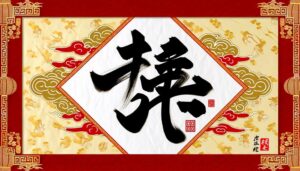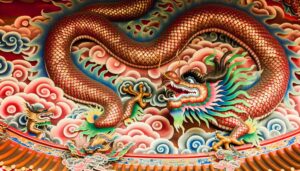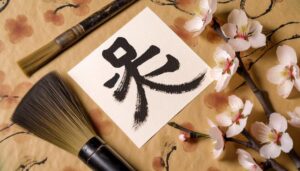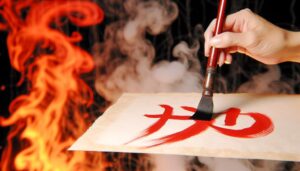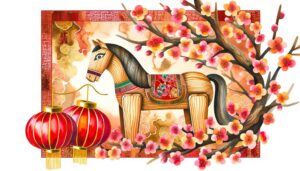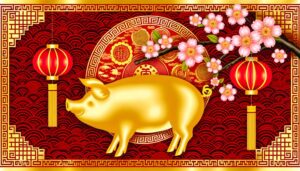What Is the Chinese Symbol for Double Happiness?
The Chinese symbol for Double Happiness, originating from ancient folklore, symbolizes marital bliss, prosperity, and multiplied joy. It is integral in traditional wedding decorations and various cultural festivals, reflecting hopes for a prosperous future.
Central to wedding ceremonies, the symbol is prominently displayed in red, representing unity and mutual joy. Additionally, it holds a significant place in community festivals, enhancing communal harmony and collective well-being.
The emblem's versatility extends to modern applications such as tattoos, home décor, and global wedding trends, showcasing its universal appeal. Explore its rich heritage and multifaceted significance to understand its enduring charm.
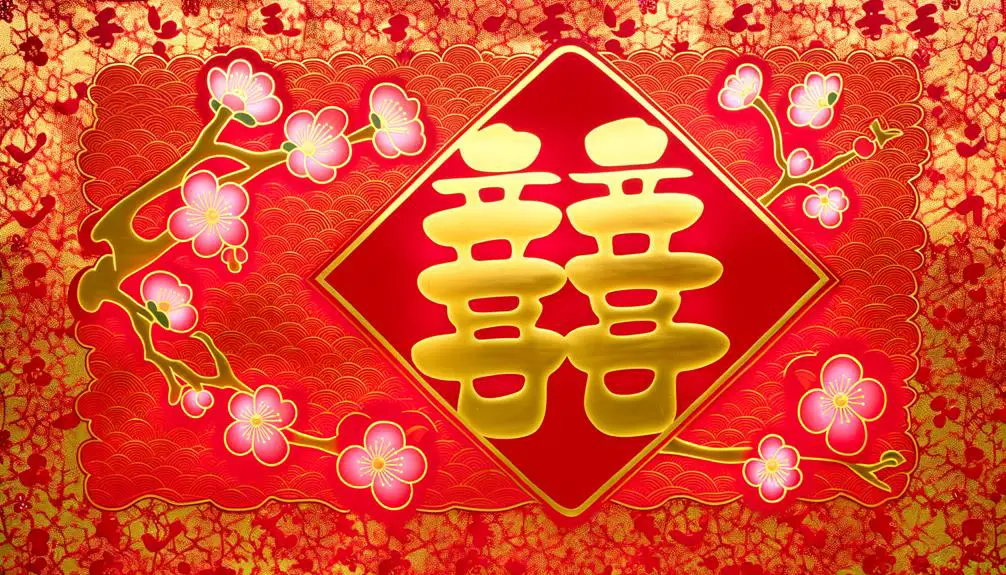
Key Takeaways
- The Chinese symbol for Double Happiness represents marital bliss, prosperity, and joy multiplied.
- It is prominently used in wedding decorations and festivals for good fortune and shared prosperity.
- Traditional, contemporary, and minimalist designs cater to various aesthetic preferences, enhancing its cultural significance.
- In Feng Shui, it is placed in the southwest sector of the house to enhance love and marital harmony.
- The symbol has a global influence, adopted in various cultures to represent joy and prosperity.
Origins in Chinese Folklore
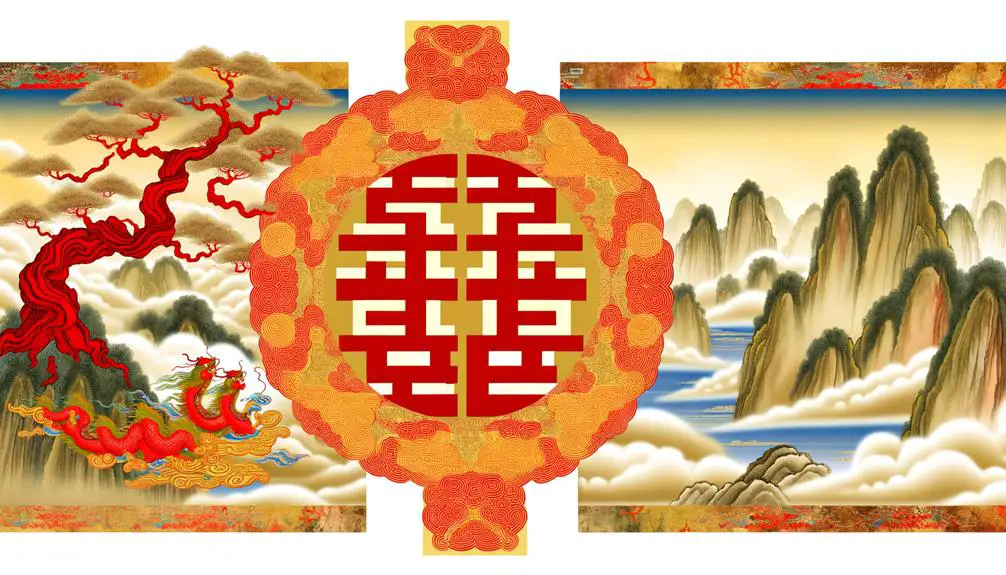
The origins of the Chinese symbol for Double Happiness can be traced back to ancient folklore, where it emerged as a significant emblem of marital bliss and prosperity.
This character, known as '囍' (shuāng xǐ), is composed of two identical '喜' (xǐ) characters, which individually mean joy or happiness.
According to legend, the symbol's creation is linked to a scholar who, during the Tang Dynasty, succeeded in both passing his imperial exams and securing his bride on the same day. The dual success was commemorated by combining the two characters, thereby forming a powerful visual representation of joy multiplied.
This amalgamation underscores the cultural emphasis on harmony and fortune in matrimonial unions, reinforcing its esteemed status in Chinese tradition.
Symbolic Meaning
Rooted deeply in Chinese culture, the Double Happiness symbol represents not only the joy of marriage but also embodies broader themes of prosperity and harmony.
This intricate character, composed of two interconnected '喜' (happiness) characters, goes beyond mere marital bliss to signify mutual joy and a balanced, fulfilling life. Its symmetrical design underscores a sense of equilibrium, reflecting the ideal of unity and mutual support.
Historically, it has been a powerful talisman, believed to attract positive energy and ward off misfortune. By encapsulating these multifaceted meanings, the Double Happiness symbol serves as a profound expression of cultural values, emphasizing the importance of collective well-being and shared fortune, extending its relevance to various aspects of life beyond matrimony.
Traditional Uses
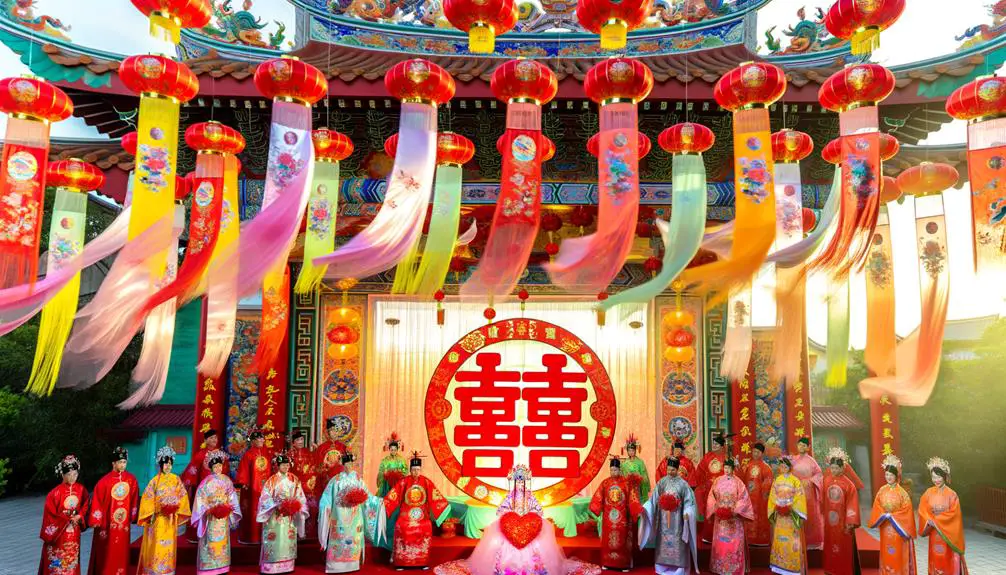
The Chinese symbol for Double Happiness holds significant traditional value, prominently featured in wedding decorations to symbolize marital bliss and harmony.
This auspicious emblem is also integral to festival celebrations, where it is believed to attract good fortune and joy.
Additionally, it serves as a popular motif in home decor items, reflecting the desire for happiness and prosperity within the household.
Wedding Decorations
In traditional Chinese weddings, the symbol for Double Happiness serves as a central decorative element, embodying cultural values and blessings for the couple's prosperous future.
This emblem, typically rendered in red, is prominently displayed throughout the wedding venue—on banners, lanterns, and even embroidered on bridal attire. Its intricate design, featuring two interconnected Chinese characters for happiness (囍), symbolizes unity and mutual joy.
The presence of Double Happiness extends beyond visual aesthetics, representing a deep-rooted cultural emphasis on marital bliss and harmony. Its usage underscores the collective hope for a successful, joyous partnership, highlighting the community's role in celebrating and supporting the couple's new journey together.
This tradition reinforces the significance of shared happiness in Chinese matrimonial customs.
Festival Celebrations
Celebrating various traditional festivals, the Chinese symbol for Double Happiness finds its place in numerous cultural festivities, extending its significance beyond weddings to occasions that emphasize communal joy and prosperity.
During the Lunar New Year, this emblem is prominently displayed to invoke good fortune and double the happiness for families.
The Mid-Autumn Festival, another major celebration, sees the symbol adorning lanterns and gift packages, representing unity and shared joy.
Additionally, during the Lantern Festival, Double Happiness often appears on lanterns and decorations, enhancing the festive atmosphere with wishes for collective well-being.
This symbol serves as a potent reminder of cultural values, emphasizing the importance of happiness, unity, and prosperity in the communal and familial spheres.
Home Decor Items
Incorporating the Chinese symbol for Double Happiness into home decor items traditionally serves to infuse living spaces with auspicious energy and cultural significance. This practice is steeped in centuries-old customs, symbolizing joy and matrimonial bliss.
Home decor items often adorned with this emblem include:
- Wall Hangings: Often placed in living rooms or bedrooms, these intricate designs symbolize enduring happiness.
- Ceramic Vases: Featuring the Double Happiness symbol, they are not only decorative but also believed to enhance harmony within the household.
- Cushion Covers: These serve as subtle yet meaningful accents, infusing daily life with traditional values.
Wedding Decorations
A central element in traditional Chinese wedding decorations is the prominent display of the double happiness symbol, which signifies marital joy and prosperity. This emblem is often integrated into various decorative items, enhancing the ambiance with its auspicious connotation. Its usage spans across numerous elements, from wall hangings to table settings, creating a cohesive and culturally rich atmosphere.
| Element | Placement | Emotional Impact |
|---|---|---|
| Wall Hangings | Entrances, Main Hall | Welcoming, Grand |
| Table Settings | Dining Tables | Intimate, Celebratory |
| Invitations | Guest Invitations | Anticipatory, Exciting |
The symbol's visual presence reinforces the couple's union and the blessings bestowed upon their new life together. By embedding this traditional icon in wedding decor, the event exudes a sense of continuity and cultural heritage.
Festive Celebrations
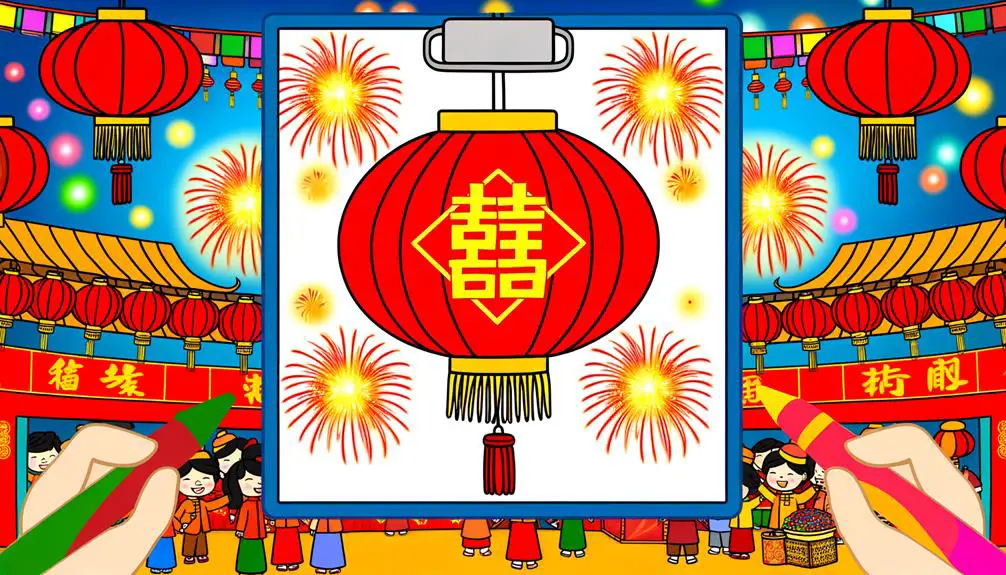
Among the myriad of festive celebrations, the Chinese symbol for double happiness holds a particularly esteemed position, symbolizing an abundance of joy and prosperity. This emblem, often depicted in red, transcends its traditional use at weddings and finds resonance in various other festive contexts. Its presence is keenly felt during Lunar New Year, where it embodies the collective aspirations for familial and communal harmony.
Additionally, the symbol is prominently displayed at milestone birthdays and anniversaries, underscoring its role in perpetuating happiness and longevity.
- Lunar New Year: Double happiness symbols adorn homes and public spaces, enhancing the festive atmosphere.
- Milestone Celebrations: Used to mark significant birthdays and anniversaries, reinforcing joyous milestones.
- Cultural Events: Featured in community festivals, fostering a sense of unity and shared prosperity.
Double Happiness in Art
The double happiness symbol, with its intricate calligraphy and rich cultural significance, has become a recurring motif in various forms of Chinese art, reflecting both traditional aesthetics and contemporary reinterpretations.
Historically, it appears in ceramics, textiles, and woodwork, often embellished with auspicious colors like red and gold. These applications not only enhance the visual appeal but also embed cultural values within the art.
Contemporary artists have embraced the symbol, integrating it into modern media such as digital art and installations. This evolution underscores a dialogue between past and present, preserving the symbol's essence while adapting it to new artistic contexts.
Consequently, the double happiness symbol remains a dynamic element in Chinese artistic expression, bridging tradition and innovation.
Modern Applications
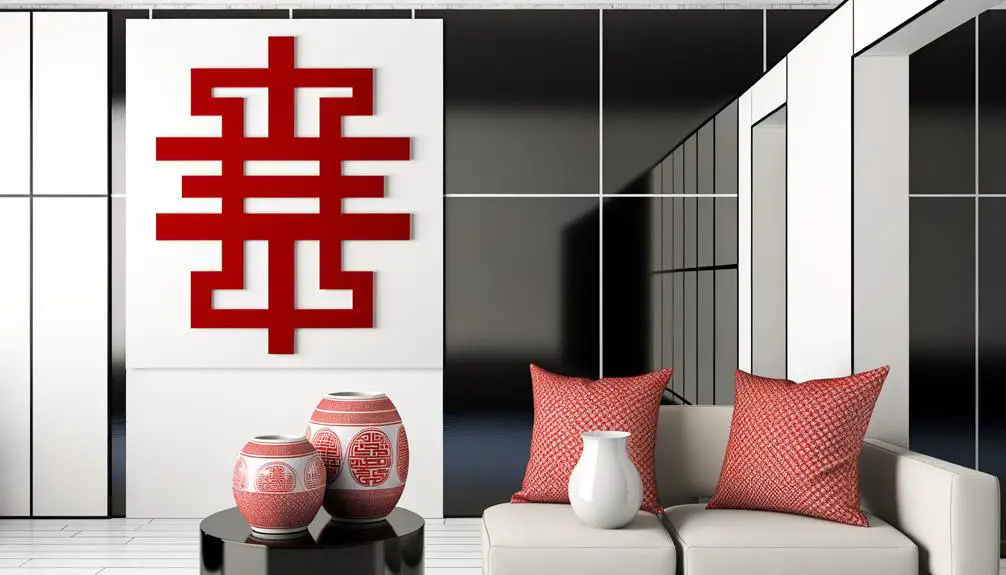
Contemporary utilization of the double happiness symbol extends beyond traditional artistic mediums into areas such as fashion, architecture, and digital design, reflecting its evolving significance in modern society.
In fashion, the symbol adorns everything from haute couture to everyday wear, symbolizing good fortune and joy.
Architectural designs often incorporate the emblem into structures and interior decorations, enhancing cultural heritage and aesthetic appeal.
Digital design leverages the symbol in various media, from websites to apps, to evoke cultural resonance and emotional connection.
This multifaceted application underscores its timeless relevance.
Double Happiness Tattoos
Double Happiness tattoos have grown in popularity as a meaningful way to express cultural heritage and personal connections to Chinese traditions.
This section will explore the cultural significance of the symbol, provide an overview of various design styles, and offer guidance on ideal placement to enhance both aesthetic and sentimental value.
Understanding these aspects can help individuals make informed decisions about incorporating this iconic symbol into their body art.
Cultural Significance Explained
Why do individuals choose to immortalize the Chinese symbol for double happiness through tattoos, a practice that intertwines deeply with cultural, historical, and personal significance?
The double happiness symbol (囍) is emblematic of joy and matrimonial bliss, often found in weddings and celebratory contexts.
For many, tattooing this symbol represents a profound connection to cultural heritage and an enduring commitment to the values it signifies. Additionally, the symbol serves as a talisman of good fortune and a reminder of life's joyous moments.
- Cultural Heritage: Embeds a sense of identity and tradition.
- Symbolism: Represents joy, love, and prosperity.
- Personal Significance: Marks meaningful life events and relationships.
Design Styles Overview
Given the profound cultural and personal significance of the double happiness symbol, various design styles have emerged to cater to individual aesthetic preferences and symbolic interpretations in tattoo art.
Traditional designs often feature the symbol in bold, black ink, maintaining the classic Chinese calligraphy style.
Contemporary renditions incorporate elements like watercolor effects, providing a softer, more modern look.
Minimalist versions use clean lines and negative space to create a sleek, subtle aesthetic.
Some designs integrate additional motifs such as lotus flowers or dragons, enhancing the symbol's meaning.
Placement Ideas Guide
Selecting the perfect location for a double happiness tattoo involves taking into account factors such as visibility, symbolism, and personal significance. The double happiness symbol, steeped in cultural heritage, requires thoughtful positioning to enhance its meaning.
Here are some placement ideas to consider:
- Wrist: Allows for easy visibility and acts as a constant reminder of the symbol's importance.
- Upper Back: Provides a canvas for larger designs and can be hidden or shown depending on the clothing.
- Ankle: Provides a subtle yet classy spot, ideal for those who prefer a discreet look.
Each placement comes with distinct implications, affecting how the tattoo is perceived and felt by the wearer. Thoughtfully assessing these factors can guarantee that this representation of happiness and togetherness is displayed meaningfully.
Feng Shui Significance
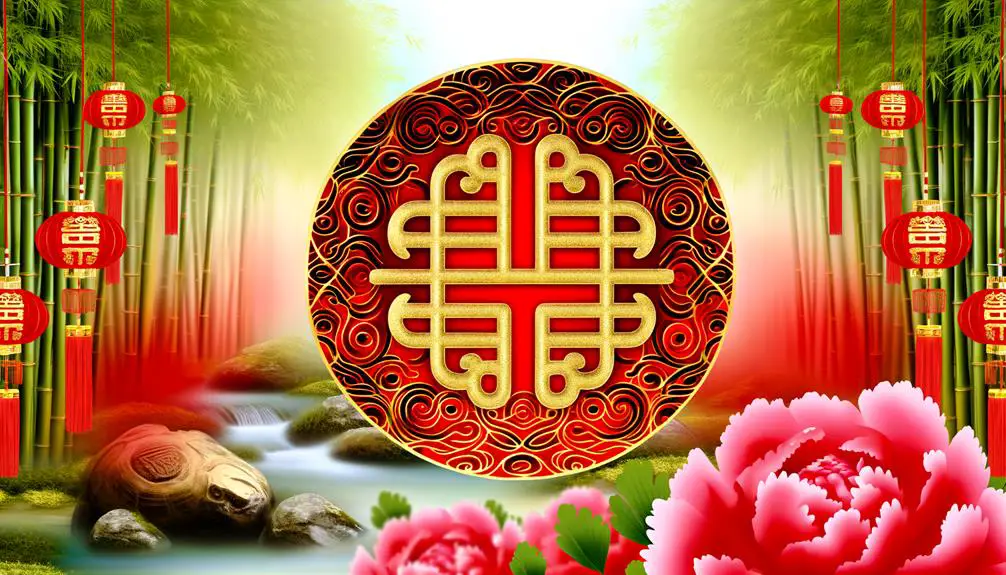
In the domain of Feng Shui, the Chinese symbol for Double Happiness is esteemed for its potent ability to attract and enhance marital bliss and familial harmony within a living space. This revered emblem is often incorporated into home decor, particularly in bedrooms or living rooms, to foster a nurturing environment for relationships.
Feng Shui practitioners advocate positioning the symbol in the southwest sector of the house, which is associated with love and marriage. Its symmetrical design embodies balance and mutual support, essential elements for a harmonious partnership.
Global Influence
The Chinese symbol for Double Happiness has transcended its cultural origins to become a global icon, prominently featured in various international contexts.
It has influenced fashion and decor trends, where its intricate design is often seen in modern aesthetics, from clothing to interior design.
Additionally, its significance in wedding traditions has been embraced worldwide, symbolizing joy and prosperity in matrimonial celebrations across diverse cultures.
Cultural Symbolism Abroad
Across various cultures outside of China, the symbol for Double Happiness has been adopted and adapted, reflecting its profound influence on global interpretations of joy and prosperity.
This emblem, originally steeped in Chinese matrimonial traditions, is now a universal icon representing positive sentiments.
Western countries, for instance, have incorporated the symbol into wedding ceremonies to signify enduring happiness and unity.
Additionally, the Double Happiness symbol is featured in various international festivals, enhancing cross-cultural appreciation.
Wedding Ceremonies: Symbolizes lasting marital bliss in diverse cultural contexts.
Festivals: Celebrated globally in events to spread joy and communal harmony.
Art and Design: Integrated into artworks, signifying a blend of tradition and modernity.
This cross-cultural adaptation underscores the universal appeal of symbols rooted in human emotions.
Fashion and Decor Trends
As the symbol for Double Happiness continues to influence cultural practices worldwide, it has also made significant inroads into global fashion and decor trends, showcasing its timeless appeal and versatility.
In fashion, the emblem is often incorporated into contemporary designs, ranging from haute couture to streetwear, symbolizing good fortune and joy. Luxury brands have adopted the motif in their collections, recognizing its aesthetic and cultural significance.
In home decor, Double Happiness appears in various forms, such as wall art, ceramics, and textiles, often used to evoke a sense of harmony and prosperity. This cross-cultural adoption underscores the symbol's universal resonance, making it a cherished and stylish element in diverse households globally.
Wedding Traditions Worldwide
Intriguingly, the Chinese symbol for Double Happiness has woven itself into various wedding traditions worldwide, reflecting its profound cultural significance and universal appeal. This emblem, traditionally signifying marital bliss and prosperity, has transcended cultural boundaries, finding resonance in diverse matrimonial customs.
Its integration can be observed in:
- Western Weddings: Adaptation in wedding invitations and décor, symbolizing fortune and joy.
- Indian Ceremonies: Incorporation into henna designs and wedding attire, blending with local motifs.
- Multicultural Celebrations: Utilization in fusion weddings, representing a harmonious blend of traditions.
Globally, the Double Happiness symbol is more than an aesthetic choice; it encapsulates shared hopes for love and unity. Its pervasive presence underscores the interconnectedness of cultural expressions in the domain of matrimonial celebrations.
Conclusion
The Chinese symbol for double joy, rooted in ancient folklore, serves as an overwhelming emblem of joy and prosperity. It permeates every aspect of life, from traditional wedding decorations to modern applications like tattoos and Feng Shui.
Its ubiquitous presence in festive celebrations and its profound global influence underscore its transcendent power. The double joy symbol, with its intricate design and deep meaning, is not merely an icon but a monumental proof of enduring cultural heritage and universal human aspirations.

